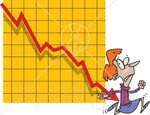 Todd Harrison wrote a piece in MarketWatch titled “The great expression,” in which he is making historical comparisons and finding positives and opportunities in a current world peppered by negatives.
Todd Harrison wrote a piece in MarketWatch titled “The great expression,” in which he is making historical comparisons and finding positives and opportunities in a current world peppered by negatives.
Let’s listen in:
Wall Street is dusting off the history books for lessons in how to deal with the financial crisis, but quickly discovering that this script has never been written.
I wrote a column in 2006 called “The State of the Art.” It discussed the shifting paradigm for the financial industry as it sat at the crossroads of technology and regulation.
Two years later, the new world order has emerged.
Fannie Mae, Freddie Mac and AIG have been all but absorbed by the government.
Bear Stearns, Washington Mutual, Wachovia Corp. and Merrill Lynch were consumed by competitors.
Lehman Brothers ceased to exist altogether.
There are many ways to view this seismic shift. There’s anger (as expressed by Main Street), sadness (as savings are destroyed), fear (as reality bites) and confusion (as folks try to understand how this could happen in the first place). And then there’s anticipation, as we cast an eye forward and look for the phoenix that will eventually arise from the scorched earth.
The unfortunate capital market destruction is an inevitable comeuppance, the cumulative result of risk gone awry. It’s been percolating under the seemingly calm surface for several years, magnified by financial engineering and consumed by an immediate gratification society.
The socioeconomic consequences will be pervasive as we endure the other side of the business cycle, an unenviable retrenchment that politicians and policy makers tried so hard to avoid. It’s certainly scary as new beginnings always are.
Therein lies the opportunity.
…
The longest recession ever — the Great Depression — lasted 44 months. In the 13 recessions dating back to 1929, the median S&P; 500 bottom occurred 58% of the way through the recession.
If our current conundrum is on par with the worst financial crisis in history in terms of duration and we assume that the business cycle peaked in the fourth quarter of 2007, we could extrapolate that the stock market bottom will arrive in the first quarter of 2010.
The media portrays the Great Depression as time when everyone in America stood on street corners waiting in a bread line. A closer look shows that much like today, economic hardship for the middle class began well before 1929.
History teaches us that the stock market crash didn’t cause the Great Depression; the Great Depression caused the stock market to crash. It was a manifestation of economic deterioration, much like the modern day sub-prime mortgage implosion.
Social mood and risk appetites shape financial markets, they always have and they always will. The current stock market malaise is, in many ways, simply catching up with preexisting societal acrimony.
We’ve got a few lean years ahead but that’s nothing to fear. In fact, it’s a healthy and positive progression. To get through this, we need to go through this. As painful as that process is, it takes us one step closer to an eventual recovery.
I view the Great Depression as the framework for optimism. Most of society worked, great discoveries were made and formidable franchises were established.
Walt Disney built their global reach during that period.
Hewlett-Packard was born on the back end.
Texas Instruments, Tyson Foods and Continental Airlines were created.
Indeed, if the greatest opportunities are bred from the most formidable obstacles, we’re about to enter an auspicious era where vast opportunities await those who are proactively prepared.
…
The past few decades were about wealth, accumulation and conspicuous consumption but we’ve now entered a period that is entirely more austere, if not more sensible. Debt reduction and the rejection of materialism will continue to manifest as we come to terms with doing more with less.
Flashy rides and big-ticket items that were once badges of honor now serve as hollow reminders of misplaced priorities. Humility, once viewed as weakness, will be embraced.
Doing for others — rather than asking what others can do for you — will become increasingly common as people appreciate what they have rather than constantly complaining about what they don’t.
It’s a lesson I learned long ago and I’m a better man for it.
This mess is a bitter pill to swallow, particularly for the mainstream American who doesn’t know a derivative from a dividend. We can point fingers and wallow in the “why” or take a deep breath and begin the process of recovery.
Something good comes from all things bad and the greatest wisdom is bred as a function of pain.
It’s unfortunate that the structural foundation of the global capital market system had to shake before people — and policy makers — paid attention, but it is what it is, and we’ll do what we must.
Surround yourself with people you trust. Practice risk management over reward chasing. Preserve capital, reduce debt and become financially aware of your surroundings.
It won’t be an easy road but it won’t be impossible either. This too shall pass.
I agree with his assessment, especially with the fact that great opportunities lie ahead. From my vantage point, that simply means that there will be a reward for those investors who are disciplined and follow an unemotional approach to growing their portfolios.
Eventually this bear market will come to an end and, depending on its duration, many will by then have sworn to never invest in the stock market again. That’s when the trends will turn upwards, and we will re-enter the market place at a time of much lower prices than we sold for on 6/23/08.
Even though I may sound like a broken record, measurable market trends, as represented by our Trend Tracking Indexes (TTIs), are the only “real” numbers in today’s world of non-transparency of corporate books and questionable holdings, which are marked to fantasy and not to market.
This short bear market has shown, as have all the others in the past, that blind investing and reliance on buy-and-hold with all its diversification schemes has done nothing but cause incredible pain to the Main Street investor.
Unfortunately, the lessons learned will soon be forgotten during the next bullish period, whenever it occurs, as Wall Street and the media will then again promote that same old buy-and-hold song: No changes—let’s get back to business as usual.
 As you can imagine, with the markets having devastated many portfolios, I have received a lot of client and reader mail expressing how this crisis has affected them, and how trend tracking has made a difference to those who followed its signals.
As you can imagine, with the markets having devastated many portfolios, I have received a lot of client and reader mail expressing how this crisis has affected them, and how trend tracking has made a difference to those who followed its signals.






